Analyzing the Long Run Prospects of Singaporean Farms
VerifiedAdded on 2022/12/27
|11
|2128
|89
Report
AI Summary
This report analyzes the long-run prospects of farms in Singapore, focusing on the context of managerial economics. It begins with an executive summary highlighting Singapore's reliance on food imports and the report's focus on perfect competition within the agricultural sector. The introduction provides background on Singapore's food import dependency, the small size of its domestic farms, and the rising demand for imported food. The report then examines the market structure, identifying Singaporean farms as operating under perfect competition, characterized by numerous small farmers, standardized products, and free entry and exit. The short-run and long-run scenarios for firms under perfect competition are explored, including profit maximization, the impact of new entrants, and the eventual equilibrium where firms earn normal profits. The conclusion summarizes the key findings, emphasizing the perfect competition model and the challenges of food security. Finally, the report recommends optimizing production and promoting sustainable fish farming to achieve long-term food security goals. The report references the Singapore government's goal to produce 30% of its nutritional needs by 2030, and the importance of technology and sustainable practices.
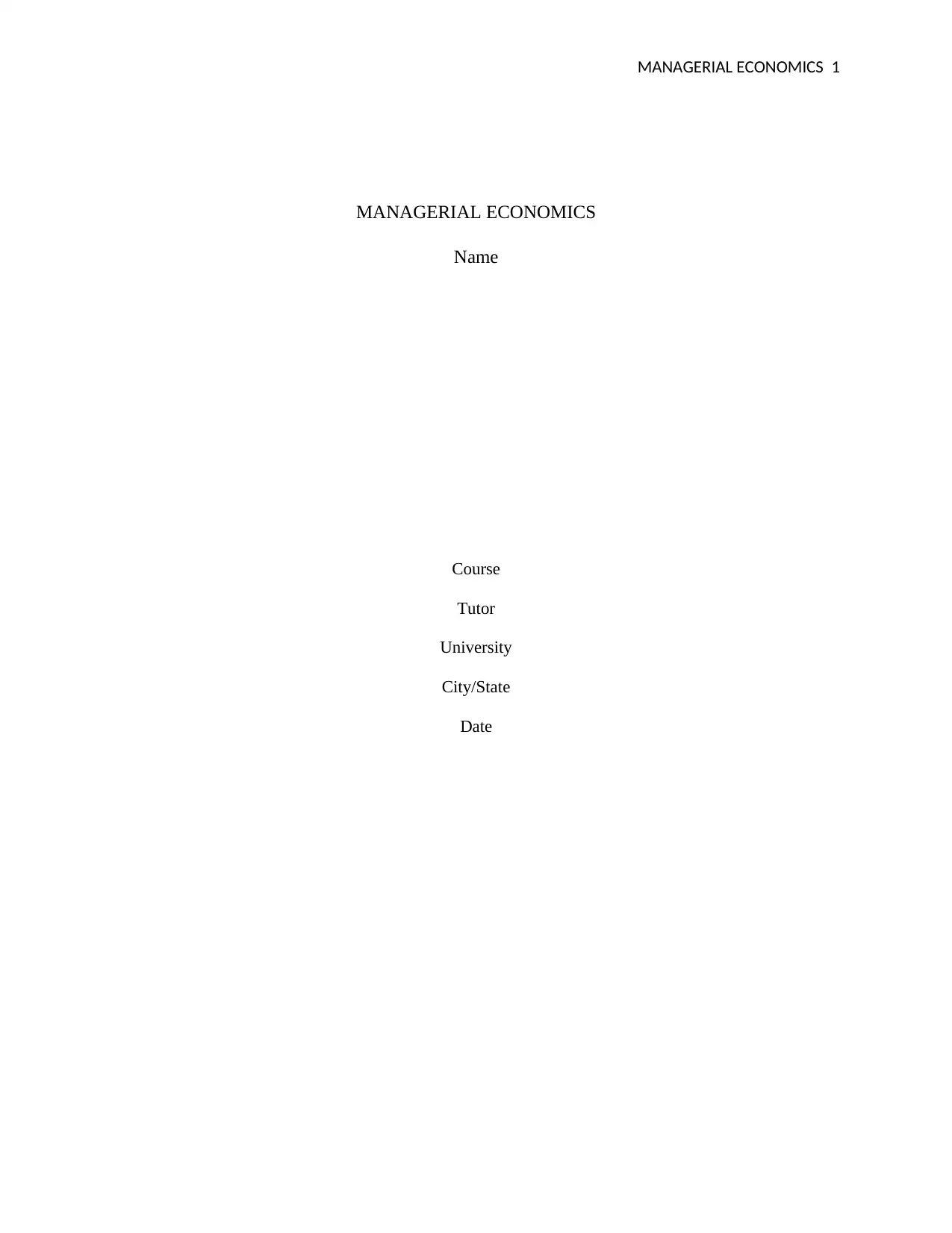
MANAGERIAL ECONOMICS 1
MANAGERIAL ECONOMICS
Name
Course
Tutor
University
City/State
Date
MANAGERIAL ECONOMICS
Name
Course
Tutor
University
City/State
Date
Paraphrase This Document
Need a fresh take? Get an instant paraphrase of this document with our AI Paraphraser
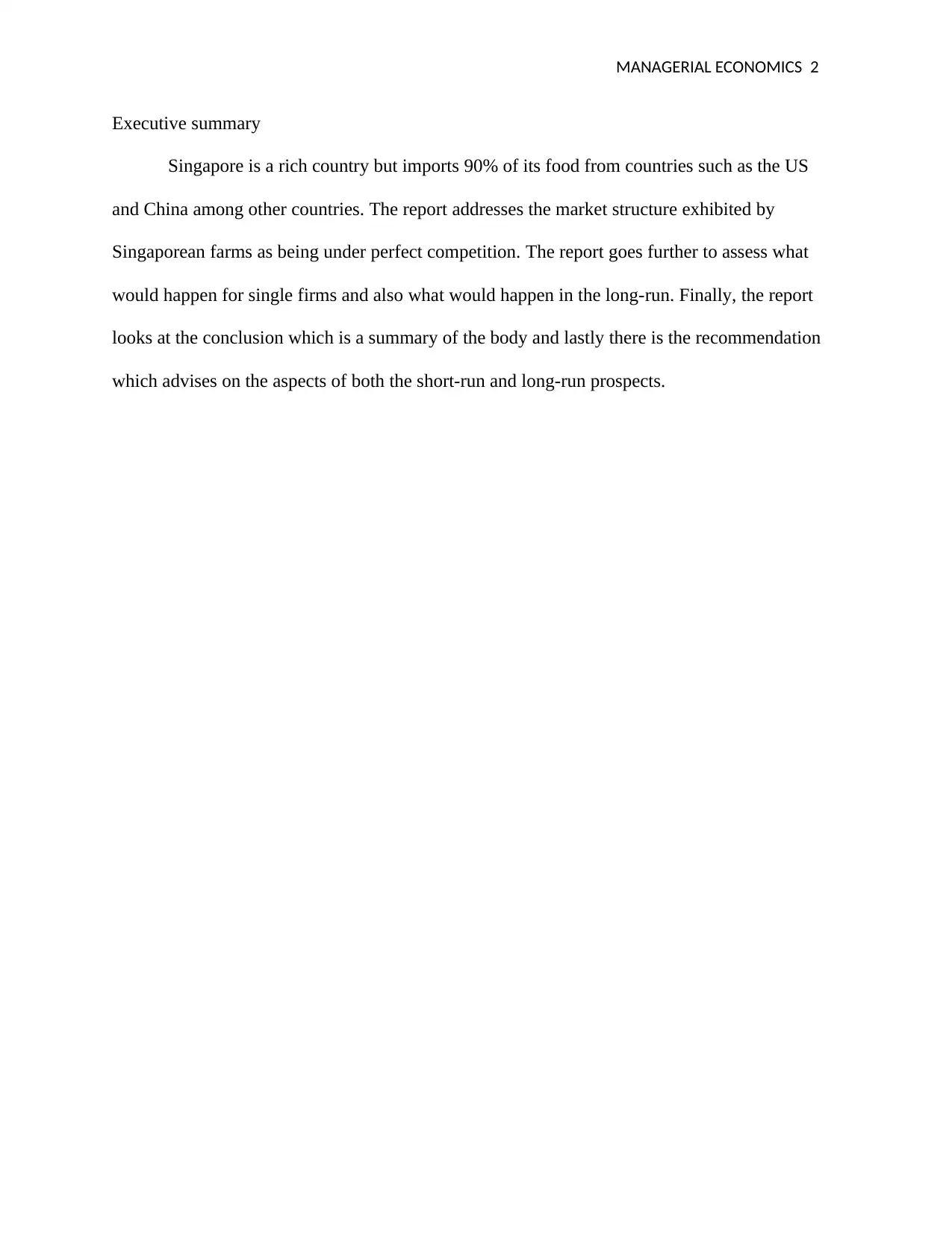
MANAGERIAL ECONOMICS 2
Executive summary
Singapore is a rich country but imports 90% of its food from countries such as the US
and China among other countries. The report addresses the market structure exhibited by
Singaporean farms as being under perfect competition. The report goes further to assess what
would happen for single firms and also what would happen in the long-run. Finally, the report
looks at the conclusion which is a summary of the body and lastly there is the recommendation
which advises on the aspects of both the short-run and long-run prospects.
Executive summary
Singapore is a rich country but imports 90% of its food from countries such as the US
and China among other countries. The report addresses the market structure exhibited by
Singaporean farms as being under perfect competition. The report goes further to assess what
would happen for single firms and also what would happen in the long-run. Finally, the report
looks at the conclusion which is a summary of the body and lastly there is the recommendation
which advises on the aspects of both the short-run and long-run prospects.
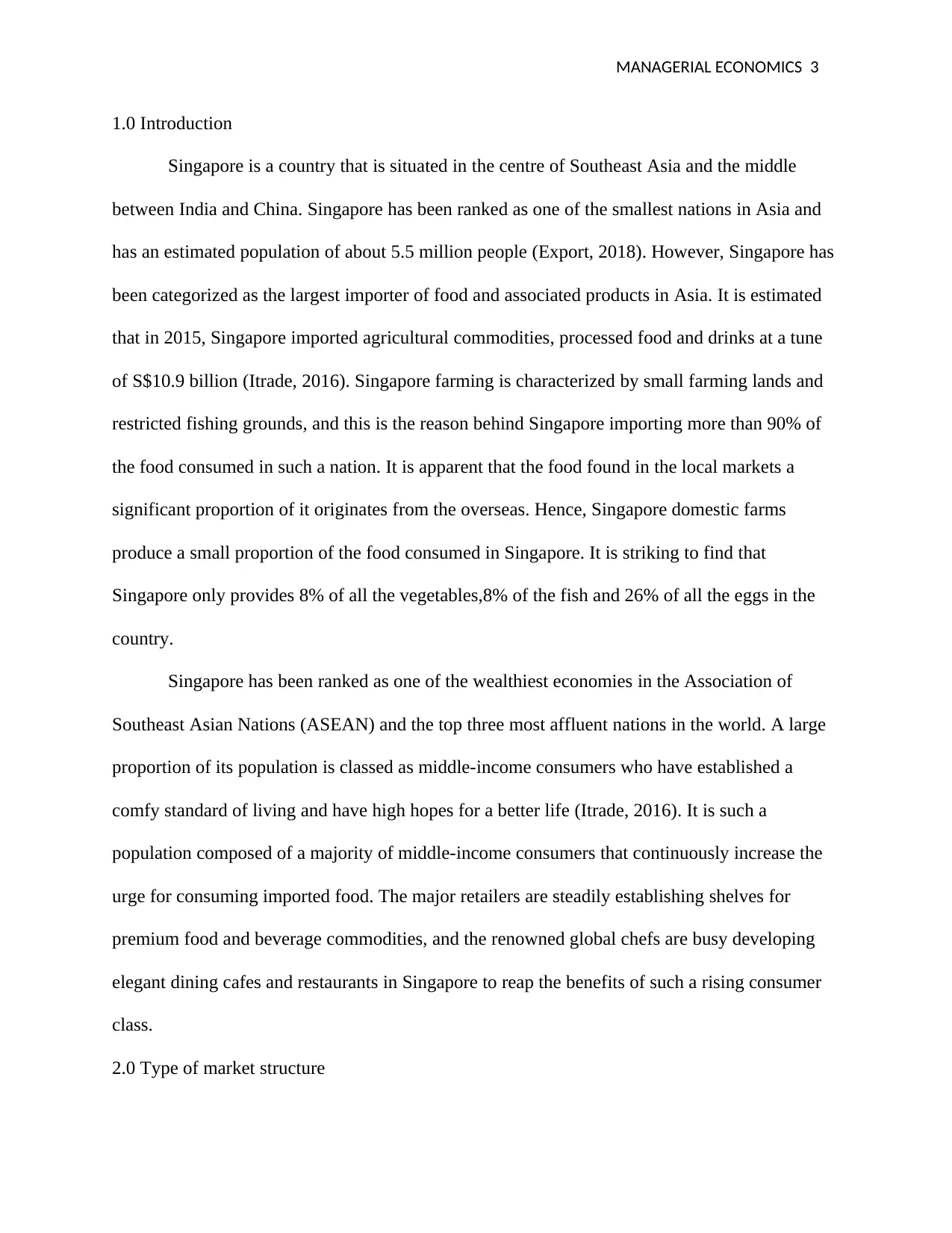
MANAGERIAL ECONOMICS 3
1.0 Introduction
Singapore is a country that is situated in the centre of Southeast Asia and the middle
between India and China. Singapore has been ranked as one of the smallest nations in Asia and
has an estimated population of about 5.5 million people (Export, 2018). However, Singapore has
been categorized as the largest importer of food and associated products in Asia. It is estimated
that in 2015, Singapore imported agricultural commodities, processed food and drinks at a tune
of S$10.9 billion (Itrade, 2016). Singapore farming is characterized by small farming lands and
restricted fishing grounds, and this is the reason behind Singapore importing more than 90% of
the food consumed in such a nation. It is apparent that the food found in the local markets a
significant proportion of it originates from the overseas. Hence, Singapore domestic farms
produce a small proportion of the food consumed in Singapore. It is striking to find that
Singapore only provides 8% of all the vegetables,8% of the fish and 26% of all the eggs in the
country.
Singapore has been ranked as one of the wealthiest economies in the Association of
Southeast Asian Nations (ASEAN) and the top three most affluent nations in the world. A large
proportion of its population is classed as middle-income consumers who have established a
comfy standard of living and have high hopes for a better life (Itrade, 2016). It is such a
population composed of a majority of middle-income consumers that continuously increase the
urge for consuming imported food. The major retailers are steadily establishing shelves for
premium food and beverage commodities, and the renowned global chefs are busy developing
elegant dining cafes and restaurants in Singapore to reap the benefits of such a rising consumer
class.
2.0 Type of market structure
1.0 Introduction
Singapore is a country that is situated in the centre of Southeast Asia and the middle
between India and China. Singapore has been ranked as one of the smallest nations in Asia and
has an estimated population of about 5.5 million people (Export, 2018). However, Singapore has
been categorized as the largest importer of food and associated products in Asia. It is estimated
that in 2015, Singapore imported agricultural commodities, processed food and drinks at a tune
of S$10.9 billion (Itrade, 2016). Singapore farming is characterized by small farming lands and
restricted fishing grounds, and this is the reason behind Singapore importing more than 90% of
the food consumed in such a nation. It is apparent that the food found in the local markets a
significant proportion of it originates from the overseas. Hence, Singapore domestic farms
produce a small proportion of the food consumed in Singapore. It is striking to find that
Singapore only provides 8% of all the vegetables,8% of the fish and 26% of all the eggs in the
country.
Singapore has been ranked as one of the wealthiest economies in the Association of
Southeast Asian Nations (ASEAN) and the top three most affluent nations in the world. A large
proportion of its population is classed as middle-income consumers who have established a
comfy standard of living and have high hopes for a better life (Itrade, 2016). It is such a
population composed of a majority of middle-income consumers that continuously increase the
urge for consuming imported food. The major retailers are steadily establishing shelves for
premium food and beverage commodities, and the renowned global chefs are busy developing
elegant dining cafes and restaurants in Singapore to reap the benefits of such a rising consumer
class.
2.0 Type of market structure
⊘ This is a preview!⊘
Do you want full access?
Subscribe today to unlock all pages.

Trusted by 1+ million students worldwide

MANAGERIAL ECONOMICS 4
Perfect competition
There are several kinds of structures characterizing different markets spanning from
perfect competition, monopoly, oligopoly and monopolistic competition (Golecha & Gan, 2016).
The type of market structure exhibited by farms in Singapore is the perfect competition that
sometimes is known as pure competition. Farming which is a form of agriculture can be
categorized as a perfect competition due to the fact it is characterized by small farmers such that
each farmer yields a neglible share of the gross market produce and hence no firm has influence
or power to control the price of such a market. Thus, in most cases, the prices and quantities are
determined by the demand and supply forces. However, in the case of Singapore due to the
country being dominated by the middle-income earners, the suppliers have control over the
prices, and at times they set premium prices as the customers have high incomes and thus, they
become inelastic to price change.
The other feature that makes farms in Singapore be classed under perfect competition is
that agricultural products are standardized or homogenous. This translates to producing farm
products where the farmers are unable to differentiate their products with regards to packaging
and labelling. Thus, with regards to farming, the customers for farm products don’t pay special
attention to the kind of particular firm they are purchasing from since all products are perfectly
identical. Thus, it becomes almost impossible for farmers to set vatying prices for the same
commodities in the same market.
Moreover, there is liberty with regards to the entry and exit in the market characterized
by perfect competition, and this is the case with farming in Singapore. Farmers have the freedom
and discretion to practice farming at their pleasure and also leaving such a market, and the
Perfect competition
There are several kinds of structures characterizing different markets spanning from
perfect competition, monopoly, oligopoly and monopolistic competition (Golecha & Gan, 2016).
The type of market structure exhibited by farms in Singapore is the perfect competition that
sometimes is known as pure competition. Farming which is a form of agriculture can be
categorized as a perfect competition due to the fact it is characterized by small farmers such that
each farmer yields a neglible share of the gross market produce and hence no firm has influence
or power to control the price of such a market. Thus, in most cases, the prices and quantities are
determined by the demand and supply forces. However, in the case of Singapore due to the
country being dominated by the middle-income earners, the suppliers have control over the
prices, and at times they set premium prices as the customers have high incomes and thus, they
become inelastic to price change.
The other feature that makes farms in Singapore be classed under perfect competition is
that agricultural products are standardized or homogenous. This translates to producing farm
products where the farmers are unable to differentiate their products with regards to packaging
and labelling. Thus, with regards to farming, the customers for farm products don’t pay special
attention to the kind of particular firm they are purchasing from since all products are perfectly
identical. Thus, it becomes almost impossible for farmers to set vatying prices for the same
commodities in the same market.
Moreover, there is liberty with regards to the entry and exit in the market characterized
by perfect competition, and this is the case with farming in Singapore. Farmers have the freedom
and discretion to practice farming at their pleasure and also leaving such a market, and the
Paraphrase This Document
Need a fresh take? Get an instant paraphrase of this document with our AI Paraphraser
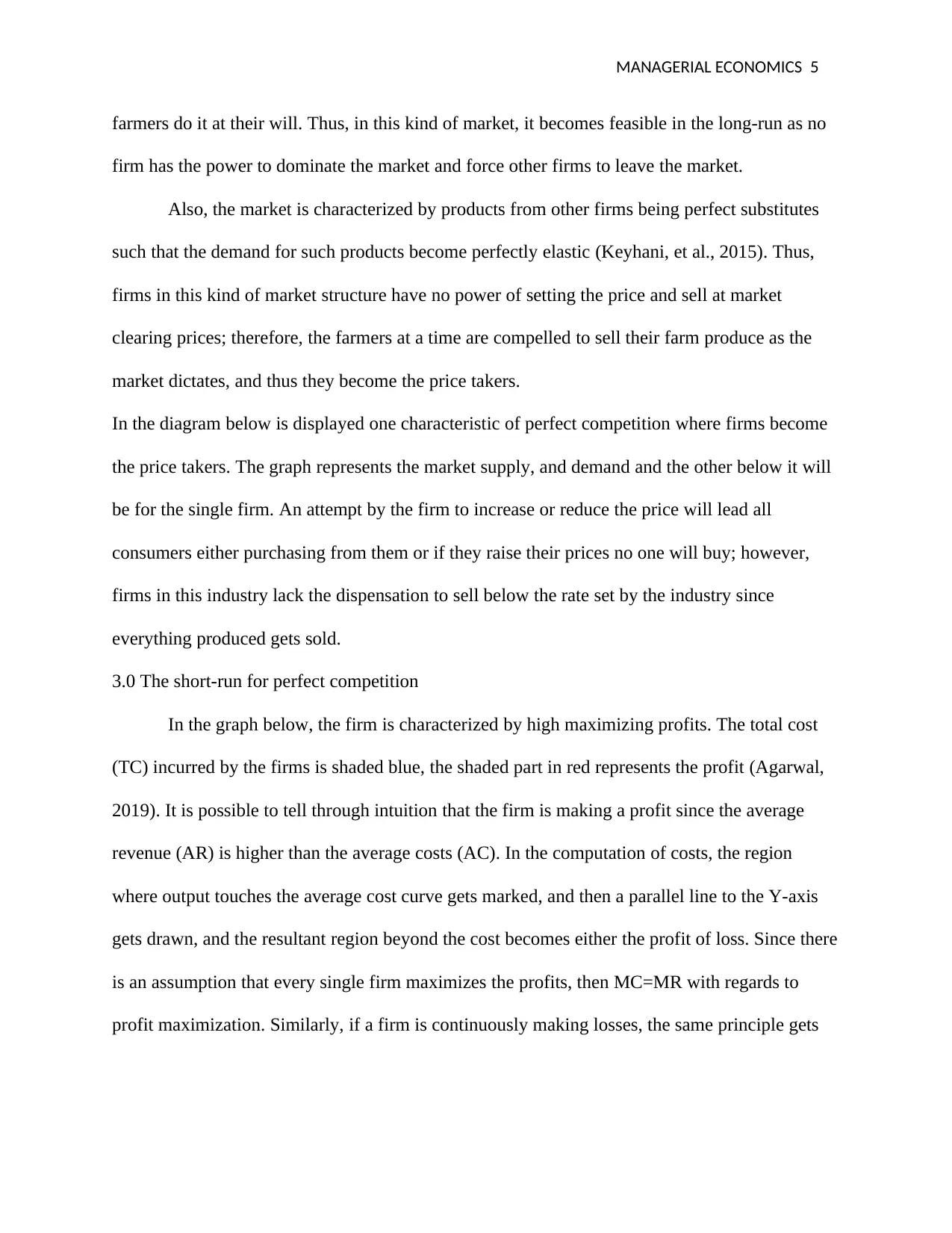
MANAGERIAL ECONOMICS 5
farmers do it at their will. Thus, in this kind of market, it becomes feasible in the long-run as no
firm has the power to dominate the market and force other firms to leave the market.
Also, the market is characterized by products from other firms being perfect substitutes
such that the demand for such products become perfectly elastic (Keyhani, et al., 2015). Thus,
firms in this kind of market structure have no power of setting the price and sell at market
clearing prices; therefore, the farmers at a time are compelled to sell their farm produce as the
market dictates, and thus they become the price takers.
In the diagram below is displayed one characteristic of perfect competition where firms become
the price takers. The graph represents the market supply, and demand and the other below it will
be for the single firm. An attempt by the firm to increase or reduce the price will lead all
consumers either purchasing from them or if they raise their prices no one will buy; however,
firms in this industry lack the dispensation to sell below the rate set by the industry since
everything produced gets sold.
3.0 The short-run for perfect competition
In the graph below, the firm is characterized by high maximizing profits. The total cost
(TC) incurred by the firms is shaded blue, the shaded part in red represents the profit (Agarwal,
2019). It is possible to tell through intuition that the firm is making a profit since the average
revenue (AR) is higher than the average costs (AC). In the computation of costs, the region
where output touches the average cost curve gets marked, and then a parallel line to the Y-axis
gets drawn, and the resultant region beyond the cost becomes either the profit of loss. Since there
is an assumption that every single firm maximizes the profits, then MC=MR with regards to
profit maximization. Similarly, if a firm is continuously making losses, the same principle gets
farmers do it at their will. Thus, in this kind of market, it becomes feasible in the long-run as no
firm has the power to dominate the market and force other firms to leave the market.
Also, the market is characterized by products from other firms being perfect substitutes
such that the demand for such products become perfectly elastic (Keyhani, et al., 2015). Thus,
firms in this kind of market structure have no power of setting the price and sell at market
clearing prices; therefore, the farmers at a time are compelled to sell their farm produce as the
market dictates, and thus they become the price takers.
In the diagram below is displayed one characteristic of perfect competition where firms become
the price takers. The graph represents the market supply, and demand and the other below it will
be for the single firm. An attempt by the firm to increase or reduce the price will lead all
consumers either purchasing from them or if they raise their prices no one will buy; however,
firms in this industry lack the dispensation to sell below the rate set by the industry since
everything produced gets sold.
3.0 The short-run for perfect competition
In the graph below, the firm is characterized by high maximizing profits. The total cost
(TC) incurred by the firms is shaded blue, the shaded part in red represents the profit (Agarwal,
2019). It is possible to tell through intuition that the firm is making a profit since the average
revenue (AR) is higher than the average costs (AC). In the computation of costs, the region
where output touches the average cost curve gets marked, and then a parallel line to the Y-axis
gets drawn, and the resultant region beyond the cost becomes either the profit of loss. Since there
is an assumption that every single firm maximizes the profits, then MC=MR with regards to
profit maximization. Similarly, if a firm is continuously making losses, the same principle gets
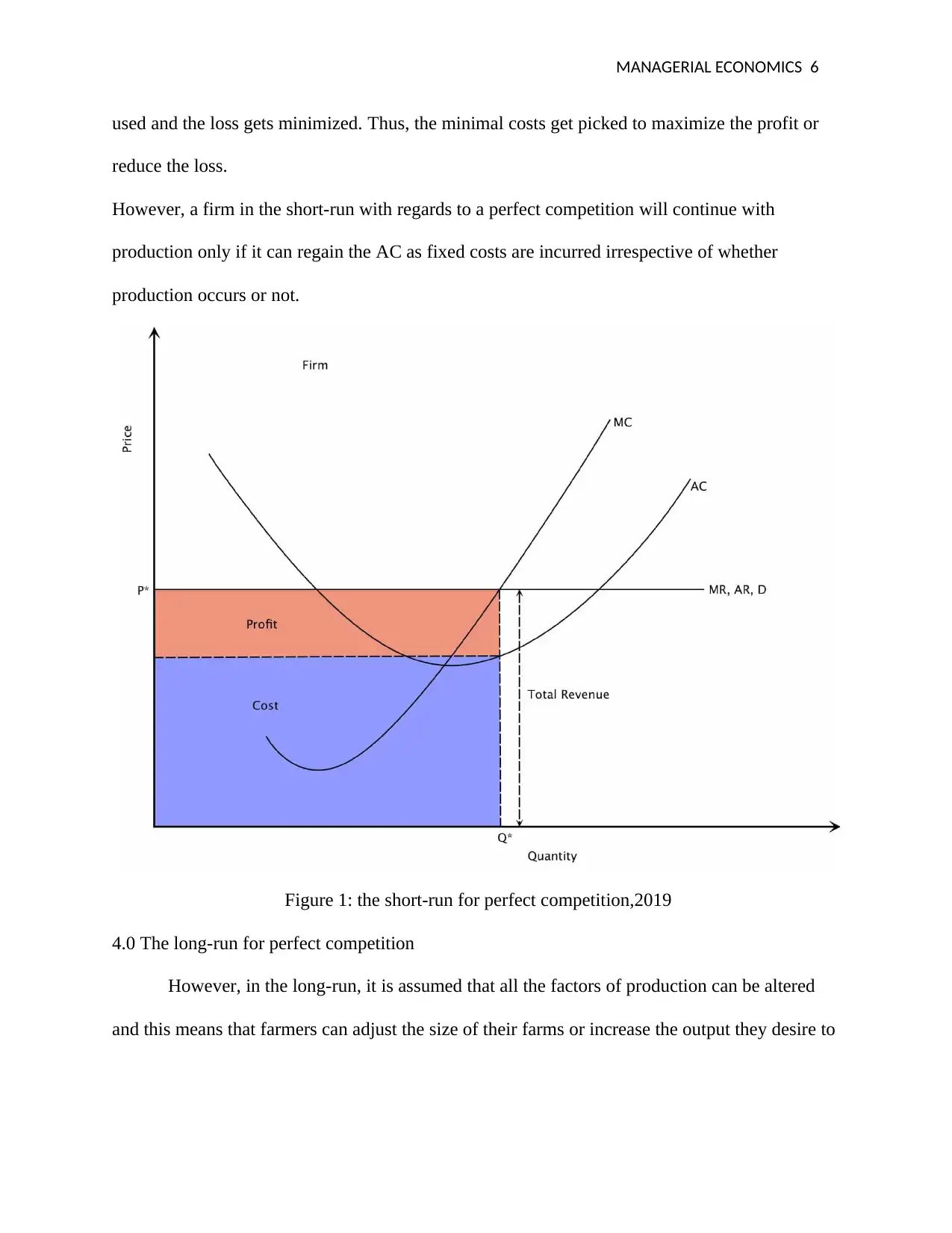
MANAGERIAL ECONOMICS 6
used and the loss gets minimized. Thus, the minimal costs get picked to maximize the profit or
reduce the loss.
However, a firm in the short-run with regards to a perfect competition will continue with
production only if it can regain the AC as fixed costs are incurred irrespective of whether
production occurs or not.
Figure 1: the short-run for perfect competition,2019
4.0 The long-run for perfect competition
However, in the long-run, it is assumed that all the factors of production can be altered
and this means that farmers can adjust the size of their farms or increase the output they desire to
used and the loss gets minimized. Thus, the minimal costs get picked to maximize the profit or
reduce the loss.
However, a firm in the short-run with regards to a perfect competition will continue with
production only if it can regain the AC as fixed costs are incurred irrespective of whether
production occurs or not.
Figure 1: the short-run for perfect competition,2019
4.0 The long-run for perfect competition
However, in the long-run, it is assumed that all the factors of production can be altered
and this means that farmers can adjust the size of their farms or increase the output they desire to
⊘ This is a preview!⊘
Do you want full access?
Subscribe today to unlock all pages.

Trusted by 1+ million students worldwide
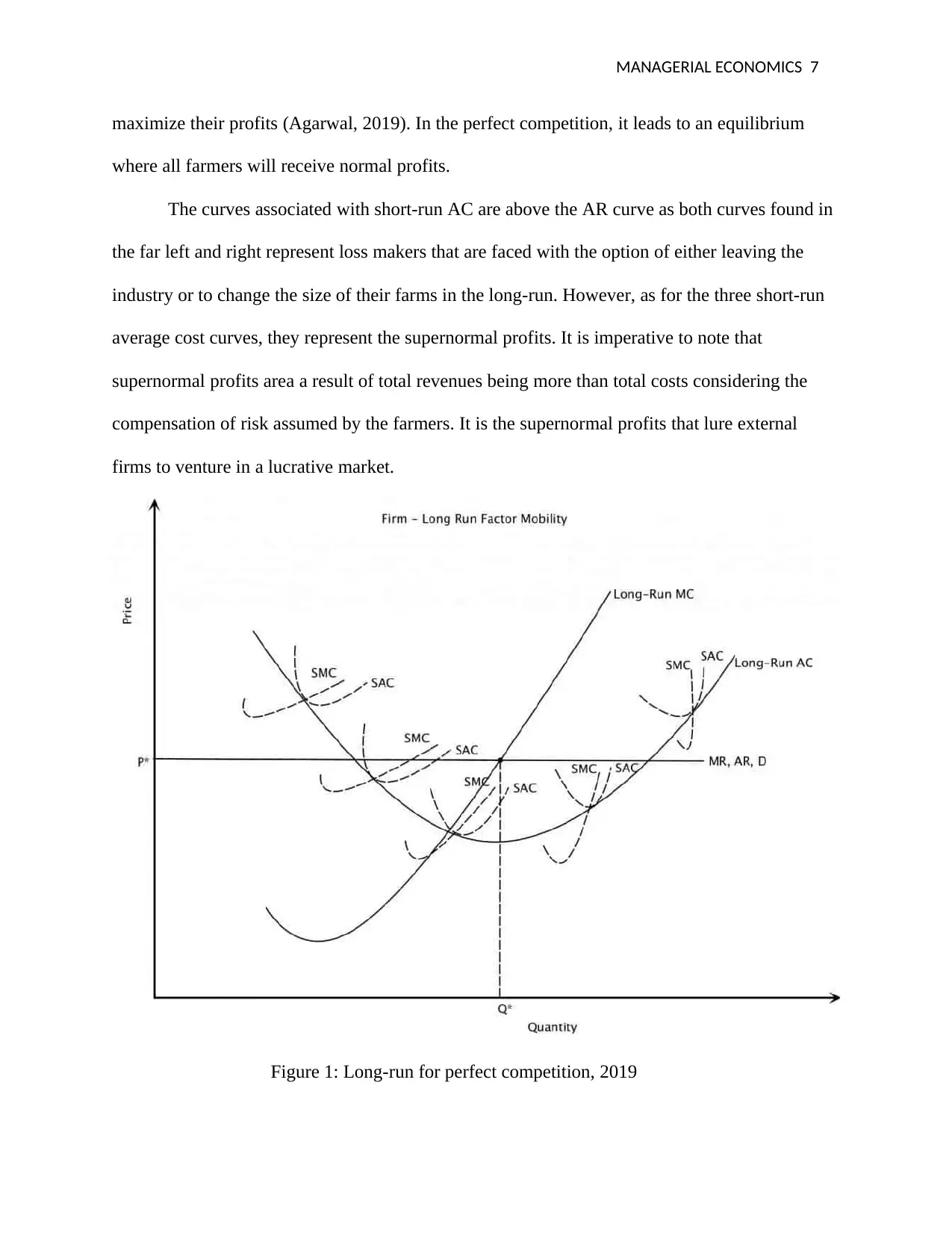
MANAGERIAL ECONOMICS 7
maximize their profits (Agarwal, 2019). In the perfect competition, it leads to an equilibrium
where all farmers will receive normal profits.
The curves associated with short-run AC are above the AR curve as both curves found in
the far left and right represent loss makers that are faced with the option of either leaving the
industry or to change the size of their farms in the long-run. However, as for the three short-run
average cost curves, they represent the supernormal profits. It is imperative to note that
supernormal profits area a result of total revenues being more than total costs considering the
compensation of risk assumed by the farmers. It is the supernormal profits that lure external
firms to venture in a lucrative market.
Figure 1: Long-run for perfect competition, 2019
maximize their profits (Agarwal, 2019). In the perfect competition, it leads to an equilibrium
where all farmers will receive normal profits.
The curves associated with short-run AC are above the AR curve as both curves found in
the far left and right represent loss makers that are faced with the option of either leaving the
industry or to change the size of their farms in the long-run. However, as for the three short-run
average cost curves, they represent the supernormal profits. It is imperative to note that
supernormal profits area a result of total revenues being more than total costs considering the
compensation of risk assumed by the farmers. It is the supernormal profits that lure external
firms to venture in a lucrative market.
Figure 1: Long-run for perfect competition, 2019
Paraphrase This Document
Need a fresh take? Get an instant paraphrase of this document with our AI Paraphraser
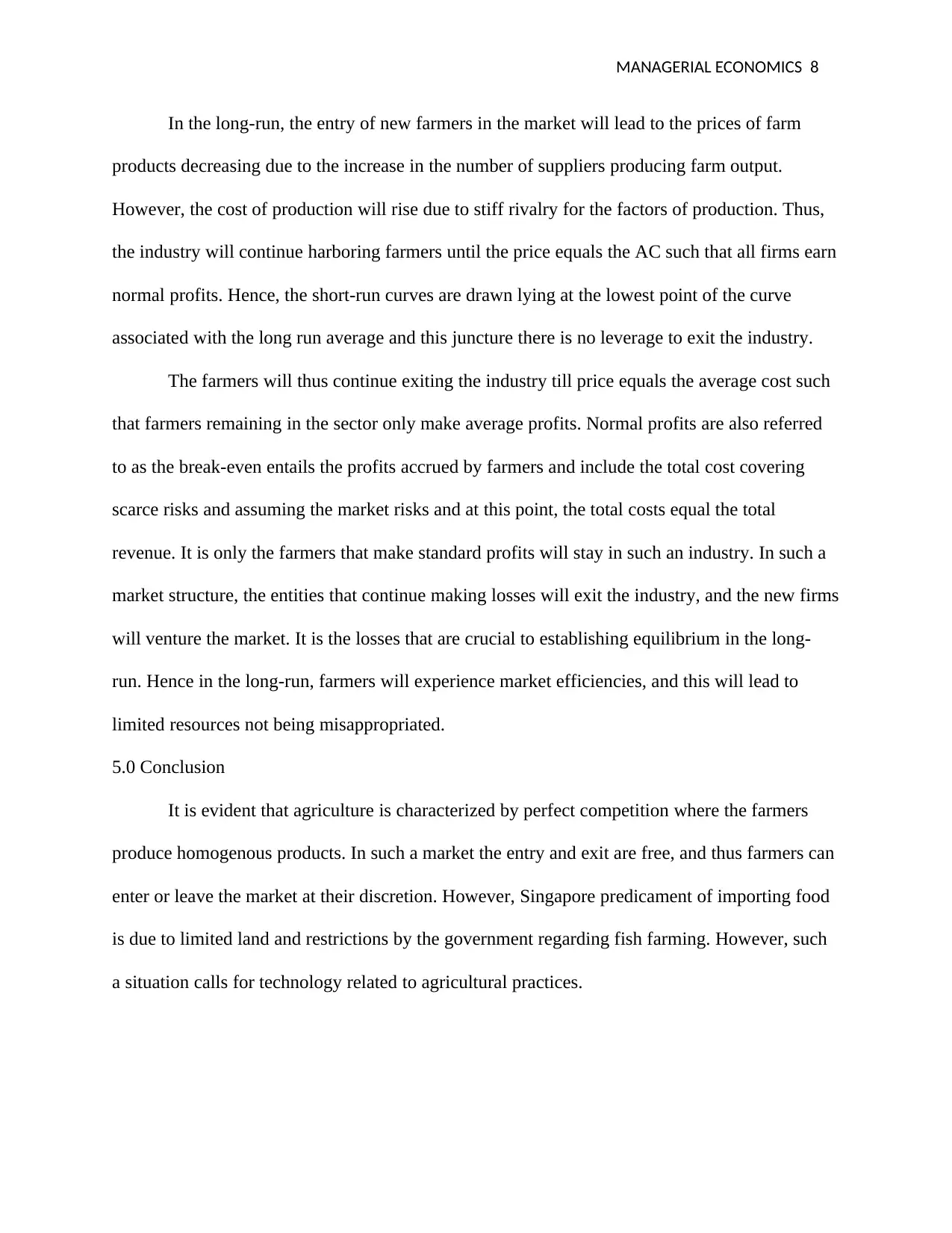
MANAGERIAL ECONOMICS 8
In the long-run, the entry of new farmers in the market will lead to the prices of farm
products decreasing due to the increase in the number of suppliers producing farm output.
However, the cost of production will rise due to stiff rivalry for the factors of production. Thus,
the industry will continue harboring farmers until the price equals the AC such that all firms earn
normal profits. Hence, the short-run curves are drawn lying at the lowest point of the curve
associated with the long run average and this juncture there is no leverage to exit the industry.
The farmers will thus continue exiting the industry till price equals the average cost such
that farmers remaining in the sector only make average profits. Normal profits are also referred
to as the break-even entails the profits accrued by farmers and include the total cost covering
scarce risks and assuming the market risks and at this point, the total costs equal the total
revenue. It is only the farmers that make standard profits will stay in such an industry. In such a
market structure, the entities that continue making losses will exit the industry, and the new firms
will venture the market. It is the losses that are crucial to establishing equilibrium in the long-
run. Hence in the long-run, farmers will experience market efficiencies, and this will lead to
limited resources not being misappropriated.
5.0 Conclusion
It is evident that agriculture is characterized by perfect competition where the farmers
produce homogenous products. In such a market the entry and exit are free, and thus farmers can
enter or leave the market at their discretion. However, Singapore predicament of importing food
is due to limited land and restrictions by the government regarding fish farming. However, such
a situation calls for technology related to agricultural practices.
In the long-run, the entry of new farmers in the market will lead to the prices of farm
products decreasing due to the increase in the number of suppliers producing farm output.
However, the cost of production will rise due to stiff rivalry for the factors of production. Thus,
the industry will continue harboring farmers until the price equals the AC such that all firms earn
normal profits. Hence, the short-run curves are drawn lying at the lowest point of the curve
associated with the long run average and this juncture there is no leverage to exit the industry.
The farmers will thus continue exiting the industry till price equals the average cost such
that farmers remaining in the sector only make average profits. Normal profits are also referred
to as the break-even entails the profits accrued by farmers and include the total cost covering
scarce risks and assuming the market risks and at this point, the total costs equal the total
revenue. It is only the farmers that make standard profits will stay in such an industry. In such a
market structure, the entities that continue making losses will exit the industry, and the new firms
will venture the market. It is the losses that are crucial to establishing equilibrium in the long-
run. Hence in the long-run, farmers will experience market efficiencies, and this will lead to
limited resources not being misappropriated.
5.0 Conclusion
It is evident that agriculture is characterized by perfect competition where the farmers
produce homogenous products. In such a market the entry and exit are free, and thus farmers can
enter or leave the market at their discretion. However, Singapore predicament of importing food
is due to limited land and restrictions by the government regarding fish farming. However, such
a situation calls for technology related to agricultural practices.
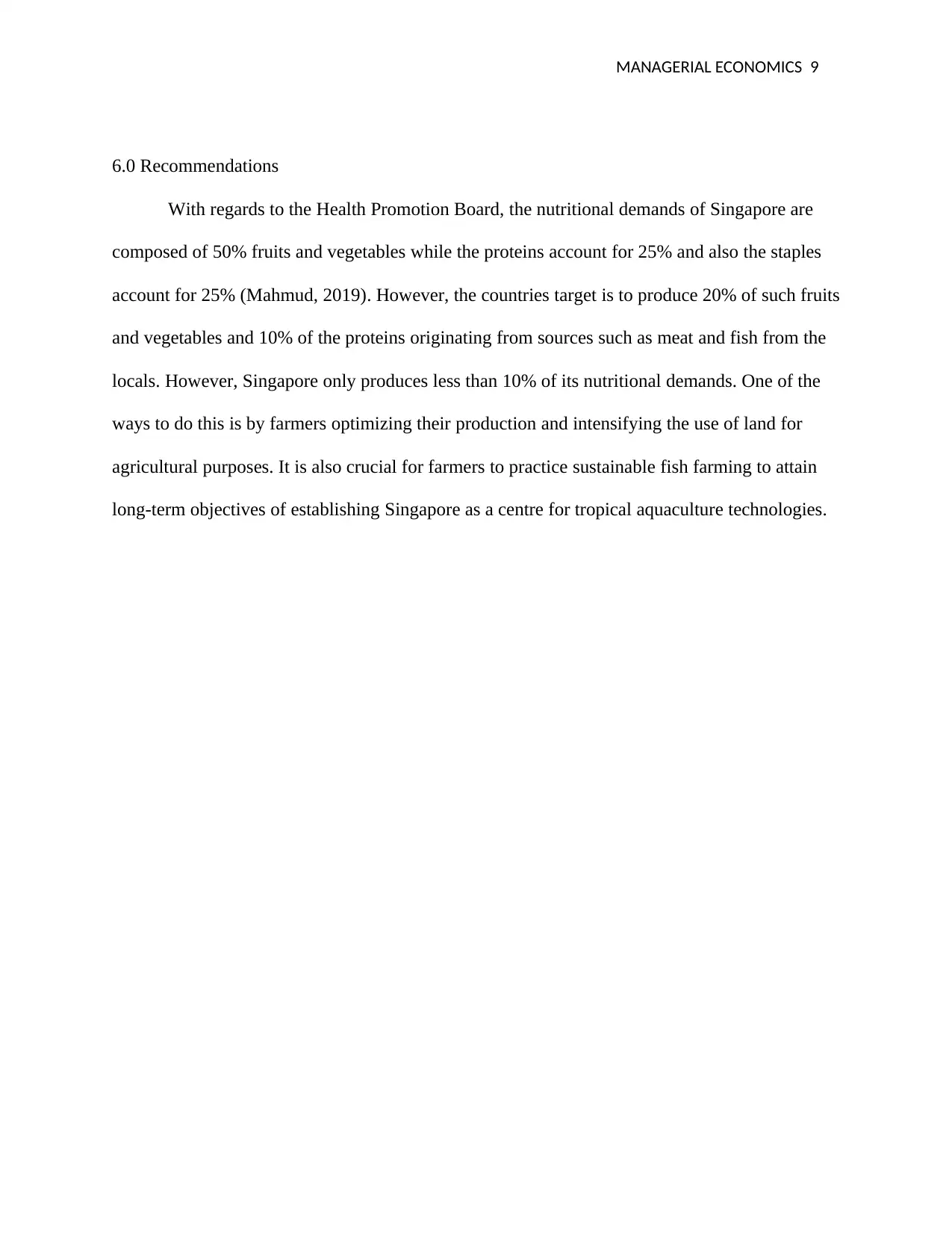
MANAGERIAL ECONOMICS 9
6.0 Recommendations
With regards to the Health Promotion Board, the nutritional demands of Singapore are
composed of 50% fruits and vegetables while the proteins account for 25% and also the staples
account for 25% (Mahmud, 2019). However, the countries target is to produce 20% of such fruits
and vegetables and 10% of the proteins originating from sources such as meat and fish from the
locals. However, Singapore only produces less than 10% of its nutritional demands. One of the
ways to do this is by farmers optimizing their production and intensifying the use of land for
agricultural purposes. It is also crucial for farmers to practice sustainable fish farming to attain
long-term objectives of establishing Singapore as a centre for tropical aquaculture technologies.
6.0 Recommendations
With regards to the Health Promotion Board, the nutritional demands of Singapore are
composed of 50% fruits and vegetables while the proteins account for 25% and also the staples
account for 25% (Mahmud, 2019). However, the countries target is to produce 20% of such fruits
and vegetables and 10% of the proteins originating from sources such as meat and fish from the
locals. However, Singapore only produces less than 10% of its nutritional demands. One of the
ways to do this is by farmers optimizing their production and intensifying the use of land for
agricultural purposes. It is also crucial for farmers to practice sustainable fish farming to attain
long-term objectives of establishing Singapore as a centre for tropical aquaculture technologies.
⊘ This is a preview!⊘
Do you want full access?
Subscribe today to unlock all pages.

Trusted by 1+ million students worldwide
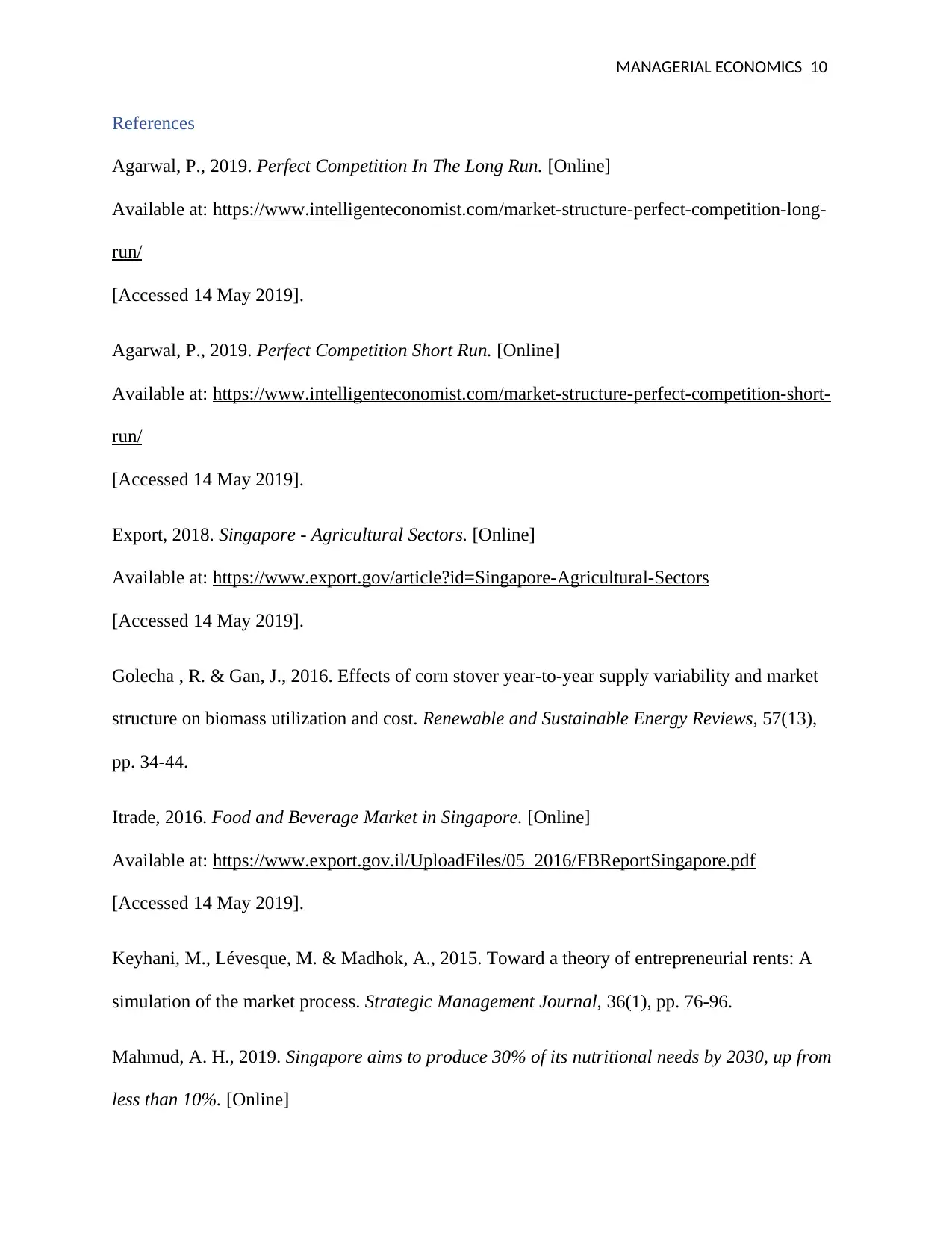
MANAGERIAL ECONOMICS 10
References
Agarwal, P., 2019. Perfect Competition In The Long Run. [Online]
Available at: https://www.intelligenteconomist.com/market-structure-perfect-competition-long-
run/
[Accessed 14 May 2019].
Agarwal, P., 2019. Perfect Competition Short Run. [Online]
Available at: https://www.intelligenteconomist.com/market-structure-perfect-competition-short-
run/
[Accessed 14 May 2019].
Export, 2018. Singapore - Agricultural Sectors. [Online]
Available at: https://www.export.gov/article?id=Singapore-Agricultural-Sectors
[Accessed 14 May 2019].
Golecha , R. & Gan, J., 2016. Effects of corn stover year-to-year supply variability and market
structure on biomass utilization and cost. Renewable and Sustainable Energy Reviews, 57(13),
pp. 34-44.
Itrade, 2016. Food and Beverage Market in Singapore. [Online]
Available at: https://www.export.gov.il/UploadFiles/05_2016/FBReportSingapore.pdf
[Accessed 14 May 2019].
Keyhani, M., Lévesque, M. & Madhok, A., 2015. Toward a theory of entrepreneurial rents: A
simulation of the market process. Strategic Management Journal, 36(1), pp. 76-96.
Mahmud, A. H., 2019. Singapore aims to produce 30% of its nutritional needs by 2030, up from
less than 10%. [Online]
References
Agarwal, P., 2019. Perfect Competition In The Long Run. [Online]
Available at: https://www.intelligenteconomist.com/market-structure-perfect-competition-long-
run/
[Accessed 14 May 2019].
Agarwal, P., 2019. Perfect Competition Short Run. [Online]
Available at: https://www.intelligenteconomist.com/market-structure-perfect-competition-short-
run/
[Accessed 14 May 2019].
Export, 2018. Singapore - Agricultural Sectors. [Online]
Available at: https://www.export.gov/article?id=Singapore-Agricultural-Sectors
[Accessed 14 May 2019].
Golecha , R. & Gan, J., 2016. Effects of corn stover year-to-year supply variability and market
structure on biomass utilization and cost. Renewable and Sustainable Energy Reviews, 57(13),
pp. 34-44.
Itrade, 2016. Food and Beverage Market in Singapore. [Online]
Available at: https://www.export.gov.il/UploadFiles/05_2016/FBReportSingapore.pdf
[Accessed 14 May 2019].
Keyhani, M., Lévesque, M. & Madhok, A., 2015. Toward a theory of entrepreneurial rents: A
simulation of the market process. Strategic Management Journal, 36(1), pp. 76-96.
Mahmud, A. H., 2019. Singapore aims to produce 30% of its nutritional needs by 2030, up from
less than 10%. [Online]
Paraphrase This Document
Need a fresh take? Get an instant paraphrase of this document with our AI Paraphraser
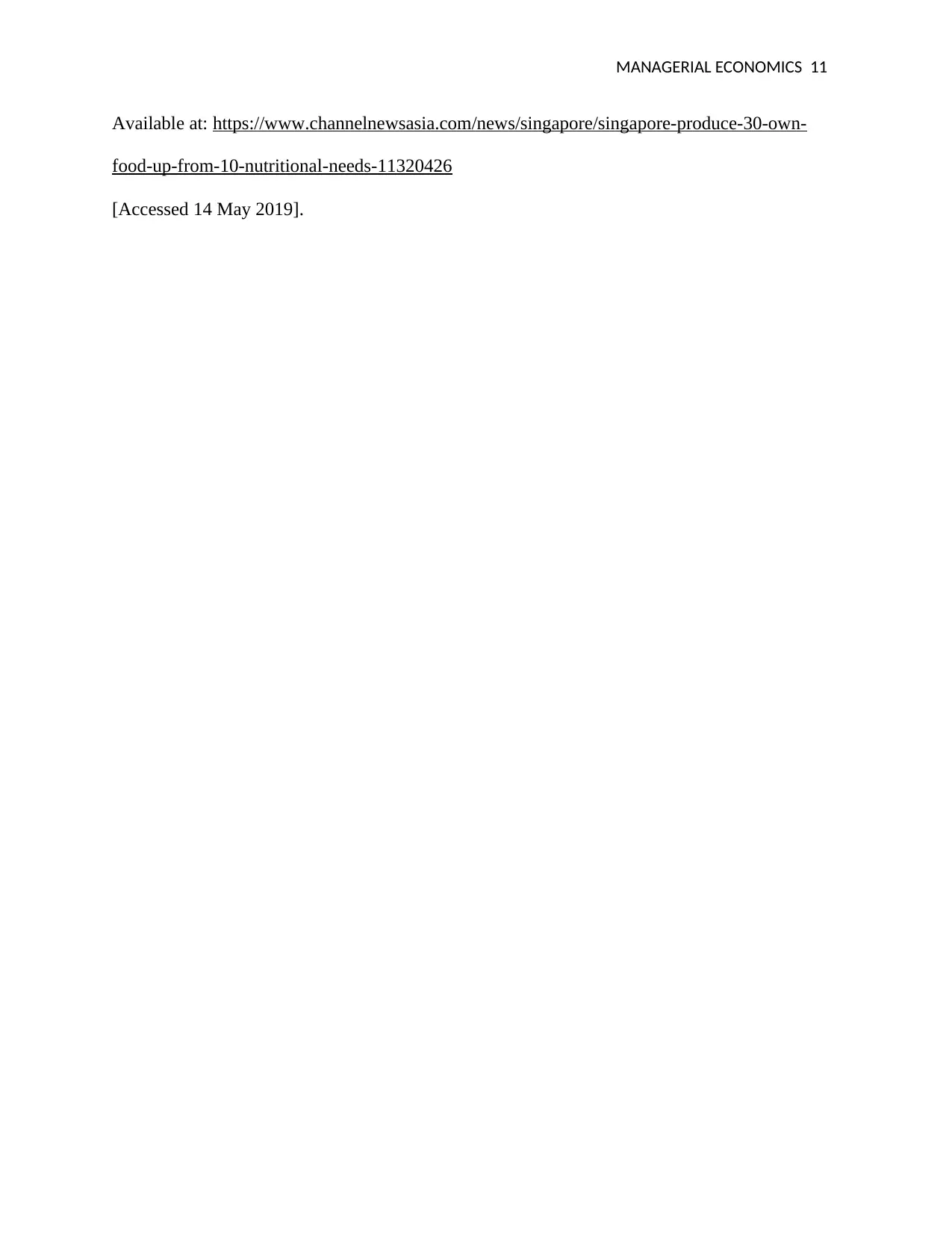
MANAGERIAL ECONOMICS 11
Available at: https://www.channelnewsasia.com/news/singapore/singapore-produce-30-own-
food-up-from-10-nutritional-needs-11320426
[Accessed 14 May 2019].
Available at: https://www.channelnewsasia.com/news/singapore/singapore-produce-30-own-
food-up-from-10-nutritional-needs-11320426
[Accessed 14 May 2019].
1 out of 11
Related Documents
Your All-in-One AI-Powered Toolkit for Academic Success.
+13062052269
info@desklib.com
Available 24*7 on WhatsApp / Email
![[object Object]](/_next/static/media/star-bottom.7253800d.svg)
Unlock your academic potential
Copyright © 2020–2025 A2Z Services. All Rights Reserved. Developed and managed by ZUCOL.



